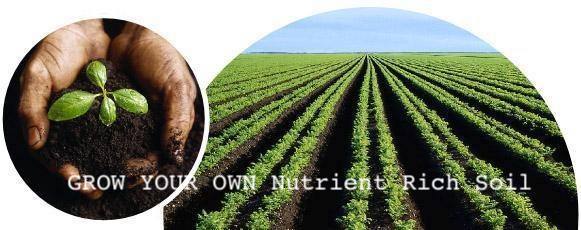How to GROW YOUR OWN Nutrient Rich Soil
No matter whether you are a home garden enthusiast or a “for profit” grower, your first goal should be to create “biology rich” soil to improve and increase your end product.
This is accomplished by gaining an understanding of what materials to avoid for your particular soil, crop and what practices to add.
The general list of things to avoid adding to the soil are most man-made materials (synthetics), including anhydrous ammonia, muriate of potash, 50 pounds or greater per acre of elemental sulfur, most herbicides, and fungicides.
This following format is intended to provide a step by step roadmap toward accomplishing your “biology rich” goal.
STEP 1: SOIL TEST There are many labs that analyze soil samples for their mineral content. We prefer an Albrecht type soil test (Kinsey Ag Services) because they are the only lab that accurately factors in the severe effects of excessive magnesium on soil structure and on the availability of both magnesium and potash to the plant.
STEP 2: APPLYING TEST RESULT Using these test results, we address mineral excesses and shortages. For example, for soils that have excess magnesium (usually found in northern California and most areas of the world), SO4-S (sulfate sulfur) is required to mitigate (leach) this problem. SO4-S comes in many forms, such as sulfate of potash, ammonium sulfate, elemental sulfur, gypsum (calcium sulfate) and many of the minor elements.
The minerals that are in short supply (shortages) will undoubtedly include calcium, potash, boron, copper and sulfate sulfur.
Soils generally have a negative charge while potassium and most minor elements are positively charged. Since opposites attract, this partially explains how soil chemistry works.
No matter what else your test shows, you should also apply small amounts of negatively charged nutrients, such as nitrogen, boron, and sulfate sulfur that will leach with rainfall and irrigation. Calcium, because its wetted molecule size is much smaller than magnesium, acts like a negative and needs to be added as well.
The above are soil correctives that greatly affect the health of soil biology.
STEP 3: Take full advantage of the “LIQUID CARBON PATHWAY”

The Liquid Carbon Pathway is a term coined by Dr. Christine Jones. It describes the phenomenon called photosynthesis where green plants magically harvest CO2 from the air with the presence of sunlight and soil moisture to create simple sugars. Then plants transform these simple sugars into a great diversity of other carbon compounds including starches, proteins, organic acids, cellulose, lignin, waxes, and oils. Many of these compounds are then translocated through the plants to their root system and exit into the soil in the form of root exudates.
Thus, the LIQUID CARBON PATHWAY. These exudates are not only instrumental in feeding soil biology for their food supply but also are instrumental in increasing soil organic matter (CARBON). You cannot have soil organic matter without carbon. With this in mind, you should take every opportunity to foliar feed needed nutrients when bloom or fungicide spraying.
STEP 4: Using compost
Applying added compost in the fall or early spring offsets the negative effects of synthetic fertilizers, weed sprays, and fungicides—in other words, to help re-establish friendly soil conditions for the biology.
STEP 5: Plant a diverse cover crop
Diverse Cover Crops promote soil health as it ties it all together with its decaying organic massive root system that has harvested unavailable (synthetic) nutrients from deep in the soil profile converting into an available (organic) form waiting for the plant’s needs. The cover crop also has a large quantity of above-ground mass that’s to be shredded and allowed to decay on the soil surface preventing excessive sunlight damage as the cover mass has a cooling effect.

Avoiding all synthetics (going cold turkey) at the beginning of your quest to become more biological is not recommended.
It should be a gradual reduction process. In general, excess synthetic nitrogen is your number one enemy. As you reduce your nitrogen rates in conjunction with doing steps 1 thru 5 above, you will encounter less disease and insect pressures, resulting in less spraying while moving toward your number one goal.
Ideally, your goal should be to greatly reduce your synthetic inputs while not experiencing a reduction in yield. How quickly you get there depends on your commitment to follow the steps in the roadmap above.
The proliferation of earthworms is an easy visual way to tell how you are progressing in your quest for a healthy soil that is sustainable and economical. When successful, earthworm castings will appear on the soil surface in massive numbers.




Leave a Reply